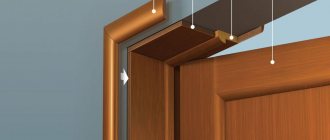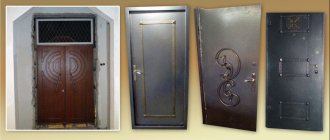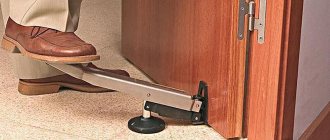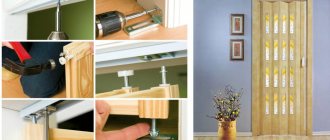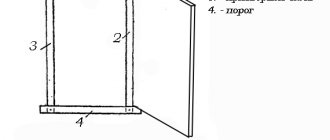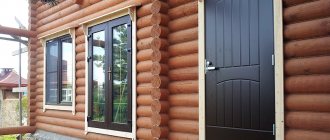To make a sliding door with your own hands, you need drawings, a description of the work plan and step-by-step instructions, because this is a rather non-trivial task, especially for a beginner. At the same time, installing a sliding door is an opportunity to save space, which is especially important when the room area is limited. In this way, you can still zone the room, without having to build durable floors. You can even make such a design with your own hands, using new materials or old fabric - you just have to purchase a special mechanism and components for it. Today we will dwell on this type of work in detail.
DIY sliding door
How do sliding systems work?
The compartment door is designed in such a way that its doors slide apart to the sides. This can be either one or two door leaves, moving parallel to the ceiling or sliding inward. And if the general operating principle of such doors is the same, then the installation and opening methods are different. Let's talk about this in more detail.
Table No. 1. Main types of sliding systems.
| View | Description |
| Mounted | In this case, the canvas is fixed on guides - on the ceiling or directly above the opening. This way the doors will move along the wall with a slight indentation from it. It is not recommended to install furniture or any other objects near the door - they will be an obstacle to the door panels. |
| Hanging | In this case, the door leaf is fixed to the cut of the opening. Accordingly, the door moves close to the wall, which looks more neat and aesthetically pleasing. Hanging doors allow you to place pieces of furniture next to the opening - they won’t get in the way. |
Table No. 2. Types of interior sliding doors by opening method
| View, illustration | Description |
Coupe | This is the most primitive version of sliding doors, so even an inexperienced person can handle the manufacture of such a model. The design comes with either one or two panels. |
Radial | The movement of the canvas does not occur along a smooth guide, but along a circle. This option is ideal for rooms with curved ceilings and is good for corner cabinets. The design has a very original appearance, but not every person can handle its manufacture. |
Cassette | They also come with one or two doors and move in different directions according to the same principle as sliding doors. The difference is that they slide into special recesses in the wall, which makes this design very convenient, because you can place furniture near the wall without any problems. Of course, making such a door will be a little more difficult, because you will have to provide for a niche in the ceiling. |
Telescopic | The design is designed in such a way that a separate guide is fixed for each blade. Such doors are often installed as interior partitions and for decoration. They can be assembled in a single part of the opening - just pull one panel by the edge, and the others will follow it. Of course, this is also a rather complex system, just like the radius, so it’s not easy to make. |
Intra-opening | The canvases are fixed in the opening and move towards each other. The design assumes the ability to open only one half of the opening. However, you can place various objects against the walls that will definitely not interfere with the opening of the doors. |
Harmonic | This is a very simple hinged door design. The canvas moves on rollers attached to the top. The disadvantages include not the best sound insulation. |
Design diagram with top movement mechanism
Prices for popular sliding door models
Sliding doors
Required tools and materials
When assembling sliding structures, make sure you have the required tools and materials. To work you will need a whole set:
- electric drill or screwdriver;
- hammer drill if necessary to remove the inner layer of the wall;
- Phillips screwdriver;
- overhead strips – 2 pcs. One of them is mounted at the top, and the other is mounted opposite the side in which the valves open.
- anchors;
- self-tapping screws;
- handles for blades – 2 units;
- finishing nails;
- two extras;
- a stand to which the doors are adjacent when in the closed position;
- accessories: rollers, fasteners, aluminum rails;
- canvas. To determine its dimensions, measure the height and width of the opening and add 70 mm to them on top;
- wooden beam with a section of 50x70 mm. The length of the beam is equal to 2 times the width of the sash plus 5 centimeters.
Armed with everything you need, move on to the next block of work.
What mounting options are there?
Depending on the type of structure, the following installation methods are distinguished:
- With two guides. They are fixed on the ceiling to a wooden beam (which is previously installed there) and from below. Thus, the canvas is securely fixed, allowing it to move smoothly and without obstacles. The only disadvantage that can be highlighted is that for the lower profile in the floor you will have to make a recess in advance using the gating method. If it is not embedded into the floor, the structure will look unsightly and the profile itself will quickly become unusable. In addition, contaminants often accumulate in it.
Doors with two tracks
- With one guide. For canvases of this type, special fasteners are provided. They are installed in the opening and move along the profile, which is located on top. An additional rail is not installed at the bottom, because usually such doors have a small mass.
Methods and stages of assembling a sliding wardrobe
The assembly order also does not depend on the type of furniture; all products have the same elements for their intended purpose. This means that they must be collected using universal technology. What are the assembly methods?
Horizontal
It is necessary to prepare a large area, free it from all interfering objects. First, the frame of the wardrobe is assembled. The bottom is placed on the edge, the sides and middle are baited to it in the same position, then the top is baited. The angles and dimensions are checked, if everything is normal, then the fasteners are tightened until they stop.
Assembling the cabinet frame in a horizontal position
Then the back wall is fixed, which significantly increases the strength of the structure. Legs or wheels are screwed to the bottom, and the frame is raised to a vertical position. Now it has sufficient strength to easily withstand all unusual loads that arise during furniture installation. Doors are always installed last.
The doors are installed last.
Advantages of this method:
- there is an opportunity to perform all the work independently;
- the risks of mechanical breakdowns of cabinet parts are minimized;
- work can be divided into several stages depending on capabilities, during which time the structure is not subjected to any loads;
- The process of checking the connection angles of individual parts is simplified.
Horizontal assembly greatly simplifies the work process.
There is only one drawback - you need a lot of free space in the room, and it is not always possible to free it up. Especially if it is residential and cluttered with a lot of furniture.
Vertical
A more complex method, it is highly recommended to involve assistants for this assembly. With this method, the legs are installed on the bottom, then the sidewalls and the middle partition are fixed to it in a vertical position. At this time, problems arise - the parts wobble and can completely tear out the connection. We need to come up with methods for temporarily fixing them or call an assistant. The second solution is more acceptable; this is the only way to fully guarantee the safety of all cabinet elements during assembly.
You will need a helper to assemble the cabinet vertically.
After installing the frame, the back wall is fixed, and then all the internal filling is installed. The doors, as always, are installed last.
Materials for making sliding doors
The reliability of the structure will also depend on the quality of the materials from which it is made, so special attention should be paid to this point.
The sliding system is a mechanism that consists of guides, rails and rollers. It can be made from various materials:
- Steel. It is these durable mechanisms that are best suited for installing heavy interior doors. They securely fix the canvas and do not deform under load. The only drawback is the noticeable noise when the doors move.
- Aluminum. Guides made of this metal should be chosen only if you plan to install a weightless canvas. One of the advantages of such a mechanism is the silent movement of the canvases.
- Plastic. A mechanism made from this material is used only for simple hinged doors.
It is recommended to use only durable, steel guides
Note! An equally important point is the choice of material for the canvas itself. In this case, the purpose of the structure will be of great importance.
Prices for different types of sliding door guides
Guides for sliding doors
Table No. 3. The most popular materials for making door leaves.
| Material | Description |
| Wood | Sliding doors are usually made from natural solid wood, which are best suited to a classic interior. It should be taken into account that the canvas will have a large mass, therefore the fastenings must be as strong as possible. In addition, if you make your own door from natural wood, you need to take care to protect the structure from fungus using special treatment. |
| MDF or chipboard | Such materials are often used to make doors, because they are much cheaper than natural wood, but at the same time have good resistance to temperature changes and humidity. However, it should be noted that MDF is much easier to saw - it is from this material that a structure of any shape can be cut. In addition, it is environmentally friendly compared to chipboard. Most often, craftsmen prefer to choose laminated panels, because such a door does not need to be primed or painted. It is strictly not recommended to use chipboard for sliding doors in a children's room, because this material contains toxic synthetic resins. |
| Plexiglas | In this case, we are not talking about standard glass, but a special organic material that is resistant to mechanical damage. Such doors have an unusual appearance - they can be matte, glossy, with or without various patterns. Of course, such a canvas serves as a decoration rather than as protection from noise or prying eyes. An excellent replacement for glass construction are polycarbonate sheets. This material also has an unusual appearance, but it is quite durable. Another obvious advantage of polycarbonate is the huge variety of colors. |
Glass doors are often used by designers to create respectable interiors.
If you have the desire and opportunity, you can combine the listed materials. Some craftsmen prefer to install glass or mirrors in wooden doors.
Important point! It is important to use only high-quality material in your work, otherwise the door leaf may become deformed. This especially often happens when natural wood is poorly processed and dried.
Prices for different types of MDF panels
MDF panels
Mounting options
Unique characteristics, high functionality, excellent ergonomic characteristics make it possible to embody the most interesting design ideas. This is very important in conditions of very limited space. And making and installing sliding doors with your own hands can be the optimal solution even in large areas.
A popular solution is to install a sliding system in one room, but between two zones.
For example, a double door helps not only to divide a room into different zones, but at the same time leave the room coherent. See how sliding doors transform a room. They are all made by hand. These photos show how the space is zoned.
Another way to use structures is a partition separating the living part of the room and a balcony or terrace. But this is only relevant for country cottages. But here the right solution would be to create sliding doors with your own hands. Through the transparent glass, sunlight will enter the room, and in summer it will also be warm. If you open the doors, the room expands indefinitely.
Often such designs are used in technical rooms. Utility rooms or storage rooms will be closed and valuable space will be saved. This technique is often used in cramped city apartments.
The most difficult sliding door to create with your own hands is the radius model. The difficulty here is not only in the production of guides, but also in the creation of the canvas.
Making a sliding door
Even a novice master can handle a simple version of the sliding design. We will look at the main stages of manufacturing a sliding door.
Before starting installation, you must prepare all materials and tools
Prices for popular models of screwdrivers
Screwdrivers
Materials and tools
During the work we will need the following devices:
- electric drill, screwdriver;
- chisel;
- electric jigsaw;
- Bulgarian;
- building level;
- roulette;
- Screwdriver Set;
- a simple pencil and a ruler.
In addition, you will need to prepare materials:
- chipboard sheets for door leaves;
- guide rails, rollers, fittings;
- bars with a cross section of 5×5 centimeters;
- anchor fastenings;
- decorative additions;
- self-tapping screws
Calculations and drawings
It is recommended to draw up a drawing of the door leaf with dimensions. To do this, we will need to first measure the doorway (it is necessary to take into account the distance to the ceiling in order to determine the method of installing the sliding doors). In addition, you should take into account the distance from the opening to the corners, because in all cases it is not enough for the sash to slide out freely.
If you decide to install a frame over a doorway, then first of all you need to take into account the thickness of the floors - if there are too crooked walls, the measurements may not match, so they will have to be double-checked several times. In addition, you should make sure that the floor is level and not sloped.
This is what the measurement diagram looks like
According to the standard, the canvas has the following dimensions:
- width – from 40 to 90 centimeters;
- height – 275 centimeters.
When making a door yourself, you should not make it too large, because the rollers may not withstand excessive load.
When choosing the classic version of sliding doors, you need to make a leaf that will be 20-50 millimeters higher than the opening. The width of these doors should be 20-30 millimeters larger on both sides.
The table shows the maximum dimensions of door leaves. The possibility of deviation from these values is not excluded, but only to a lesser extent
In the case of installing a cassette mechanism, it is necessary to cut out the canvas exactly to the size of the opening, because first the mechanism itself will be installed, and only then the niche.
By combining materials, you can make the door leaf weightless. Here are some of the most popular lightweight design options.
If you think that it will be easier to make a door leaf from wooden blocks, then the following diagram of their connections will be useful in your work
In this case, you should use polished timber, which will not have to be further processed. In order to make the most accurate cuts, it is advisable to purchase specialized carpentry equipment.
The process of making a sliding door: step-by-step instructions
Step 1. First of all, we need to cut out a door leaf of the required size from a sheet of chipboard. This can be done at home, but it is better to turn to professional furniture makers. Next we need to process the edges. This is quite simple to do, using an iron or hair dryer with hot air, after which the edges can be cut off with a utility knife.
Treated and untreated chipboard edges
Important point! During work, you must use protective gloves for your hands and special glasses for your eyes.
Step 2. Now you need to take a wooden beam and measure the required length from it.
You should mark and saw off the beam using a jigsaw
Now, according to preliminary markings, we will need to fix the beam above the doorway (in our case it will be held on by four long screws)
Step 3. Now you need to measure the required length of the rails.
You can cut the metal guide using a grinder
Now you should make holes in the guide for the screws
It is necessary to place it on a chair, holding it with one hand, and drill through holes.
Step 4. Next you will need to screw the guide rail to the wooden block above the opening.
You need to hold it with one hand and screw in the screws one by one
Important point! If the guide is installed without a bar, then it is necessary to fix it a few centimeters further from the wall, otherwise the door will touch the trim when moving.
It is necessary to carefully check the correct position of the bar and the guide using a level, because the ability to freely open the door depends on this.
Step 5. Now you need to attach the metal fasteners from the kit to the door leaf.
We attach the hanging mounts for the rollers with self-tapping screws
Step 6. Now you should mark the location where the door handle is attached.
It is important not to make mistakes in the calculations and put marks on all sides
Now you need to make holes using a drill along the marking lines
This is necessary in order to place a jigsaw blade there and cut out a recess for attaching the handle.
You should also cut out the hole carefully, moving exactly along the marked lines.
Tips for choosing a jigsaw
It’s better not to rush here and, if necessary, make a few more holes with a drill on the other side.
The door handle mount should be installed in the resulting hole, after which you will need to insert the door handle itself
Step 7. The next step is to insert the rollers into the top guide.
You need to insert two rollers into the guide
Now you need to screw the door lock from below
The groove in the door leaf must be made using a grinder and a special circle.
Step 8. Next you need to hang the door leaf.
Using the screws located on the rollers, you should set the canvas to the optimal level, after which it can be secured with nuts
Next, you need to insert the clamps into the guide and wrap them up - this will be needed so that the door does not go beyond the rails
Step 9. The fastenings will need to be covered with decorative trim in the color of the door leaf.
First you need to measure the exact length of the extension, and then you will need to cut it to size with a jigsaw
The extension can be secured to small nails with decorative heads. It is important to carefully fix it on both sides. Now we need to mark and cut the side panels for our door. Then all that remains is to install them according to the same principle.
Upon completion of all work, it is necessary to check the functionality of the structure - the door should move smoothly along the guide without any obstacles.
Video - Sliding door from an ordinary one. DIY compartment door
This is the simplest option for making a sliding structure at home, which is suitable for beginners. If desired, you can also install a lower guide with rollers. In this case, it will be necessary to make a recess according to its dimensions in the floor. It is worth noting that this is a more modern option, because such a mechanism operates silently.
Important point! In this case, when hanging the door, the door leaf is first inserted into the lower guide, and then into the upper one.
Question details
Installation options
Installing sliding doors with your own hands is not difficult, it is only important to decide on the type of installation:
- Sliding door - guides are attached to the wall along which the canvas will roll.
- Cassette - a special niche should be made in the wall in which the door leaf will be hidden. Sometimes they are called retractable.
- Cascading - made of one stationary canvas and several moving ones. Movable ones, if necessary, can be moved and hidden behind the fixed part.
The easiest way to install is a sliding door. You can install it yourself, and not only at the repair stage, but even after it is completed. The only important thing is that the opening is smooth and the walls have good load-bearing capacity. The disadvantage of the system is that nothing can be placed close to the wall. There is another drawback - the extremely low level of sound insulation. This can be explained simply - if you look from the end, there will be a gap of several millimeters on the sides. It is required so that the canvas does not “shuffle” along the surface of the wall. In addition, all sounds will penetrate perfectly through it and will become only a little quieter.
The beauty of cassette doors is that when open, the door leaf will be in a niche and will not disturb anyone. The second advantage is that you can install seals around the entire perimeter of the opening, which will provide much higher sound insulation rates. The disadvantage of installing a door in a niche is that this can only be done during renovation, and also that to make a pencil case, a false wall is usually placed under sliding doors, and this is the best way to steal precious centimeters of space. The cascade type of doors is a type of compartment doors. Installation is the most difficult - you will need many elements, and there will also be high accuracy of installation. The systems can be classified as elite, and they rarely skimp on installation - repairs will be much more expensive.
Features and installation procedure
You can install such doors even without experience, and it will be possible to do without installers. It will take a little time, and there will also be installation instructions. We tried to provide you with a detailed description of the process with photos and videos.
Installation of sliding doors between rooms (as in a wardrobe)
The systems may differ slightly from each other, but the general requirements will remain the same.
There are several requirements that must be met before installation:
- The opening must be level, since otherwise it will be necessary to take a canvas that will cover all deviations with a margin.
- The load-bearing capacity of the sides of the doorway must be as high as the wall above it.
- The opening should be finished with plaster and paint, or covered with wallpaper/decorative panels.
Next, you should start assembling. First, attach the rollers, and all manufacturers have their own recommendations. Some advise retreating 1/5 of the width of the door leaf opening from the edge, while in other systems they will be attached immediately from the edge, and the indentation is provided by mounting plates. Install such a system - in it, roller-type platforms will be installed immediately from the corner. DIY sliding door installation depends on how you center the rollers and how smoothly everything is installed. Having positioned the plate, use a pencil or marker to mark the places for fastenings. Drill holes at the marked points, and the diameter of the drill should be 0.1 cm less than the diameter of the screw.
Align the plates and screw in all the screws. The length of the fasteners will depend on the mass of the canvas, but definitely not less than 7 cm. They should be screwed perpendicularly, as otherwise unnecessary stress may appear. The supports for the rollers should be inserted into the installed plates and secured with a lid on the side. Next, you should screw the roller platforms onto the threaded pins. In addition, before hanging it is convenient to immediately install locks and handles; it is best to take mortise ones. If you bought a ready-made kit, then you already have holes, and if you chose a regular door leaf, you will need to trace the outline yourself with a pencil and remove the excess with a chisel. After the lock or handle fits into the recess, you should mark the fastening points and drill holes for them, and then install all the fittings.
Next, let's start installing the guide. With mounted rollers, this is much easier - you will know exactly at what height the lower part of the rail should be. It will be most convenient to hang sliding doors on dry wood beams. Its cross-section should be at least 5*7 cm, and the length should be twice the width of the canvas +5 cm. Cut the guide to a similar length. Now you need to align the guide along the beam, attach it to the beam using self-tapping screws with a length of at least 8 cm. The number of fasteners should be at least three with 10 cm indentations from the edges and in the middle (more often, but not less often). Now measure at what height the timber will be placed. On doors with installed rollers, you should place a guide with a beam, and you can also mark how tall the door will be. Drill at least 4 holes in the side of the beam for mounting to the wall.
0.7-1 cm should be added to this mark - the doors should hang and not shuffle. 0.7 cm is the minimum gap, which will be sufficient if there is no floor covering in the opening. If you plan to lay carpet, laminate or linoleum, then this should also be taken into account, as well as the thickness of the coatings. To prevent the canvas from “walking” during installation, it should be wedged using small wooden wedges, and make sure that there are at least two stops near the rollers. Now attach the beam to the wall and adjust its position using a building level, and its position should be marked with a pencil. If the wall allows, then you can attach everything right through to the wall, but this requires self-tapping screws of at least 12 cm in length, and it is better to use anchor bolts.
If the walls are concrete, then you will need to install dowels. To do this, transfer the marks for the fastening to the wall surface, and this can be done using a long and thin drill, and its diameter should be slightly smaller than the drilled hole. Another simple option would be a long, thin nail. It should be inserted into the hole and with two strokes a mark should be applied to the surface of the wall. Then everything is simple - drill holes for the dowel plugs, insert the plugs and hammer everything in if necessary, and then install the doors. Stoppers should be attached to the edges of the guides, and they are driven from the blocks, and the required location is established experimentally (so that the canvas can cover the opening when closed, and at the same time rolls back sufficiently when opening).
In this case, fixation should be performed using clamping screws. Next, we open the doors and install a flag roller on the floor, which will go into the groin, sawn in the lower plane of the canvas. This is required so that the doors do not deviate vertically. To begin with, it should be inserted into the groove, the holes for fastening should be marked, drilled, and then secured using small 1.5-2 cm screws. At this point, the installation of the doors can be considered completed, and they are already fully functional. All that remains is to complete the finishing - the mounting beam should be covered with a decorative trim with a guide, and it should match the tone of the door leaf. It can be nailed to the timber with finishing nails. When inserting, make sure that the wheels are closed - this is much more beautiful.
Installation of cassette-type sliding doors
The installation process for the guide itself and hanging the door leaf almost exactly repeats all the steps described above. Only finishing is not needed, but the remaining stages are extremely important. Do-it-yourself installation of sliding interior doors (in the case of cassette type) does not use a decorative strip, and a false wall must be installed at a distance of no less than 10 cm from the wall. It is usually made from a plasterboard profile, which should be covered with wall plasterboard. But this is not important - you can use both plywood and gypsum fiber board. Why do you need a distance of 10 cm? the thickness of the door leaf and the gaps on both sides are already 5 cm, and to them it is worth adding at least the same amount to install the profile, and now 10 cm have already been used.
Due to the fact that the main load will be on the wall, the frame made of profiles does not need to be reinforced, but if you do not think that the wall is reliable, then you can put wooden blocks inside, which are screwed onto self-tapping screws, which will help make the structure very rigid. The basic principles of calculation for a pencil case, as well as the specific markings and principles of preparing a door opening for installation, can be seen in the video.
Advantages and disadvantages of sliding doors
Before you start manufacturing sliding doors, you need to carefully study all the advantages and disadvantages of such structures. It is worth considering that sliding doors are also not suitable in all cases.
Interior sliding doors can be incredibly aesthetic
The following advantages of sliding doors should be highlighted:
- such doors take up minimal space compared to any swing models;
- you can open and close the canvas without much effort; even a child can handle such actions;
- even if there is a draft in the room, the door will definitely not slam or open from it;
- this is the best way to divide a room into several zones, because glass sheets are often used as decorative partitions;
- some door designs do not provide for a threshold, so this option is suitable if disabled or elderly people live in the apartment;
- the design is perfect for any room, including the bathroom, kitchen, bedroom;
- If you have additional funds, you can install an automatic door opening mechanism.
Installing this design allows you to visually expand the wall
However, it is necessary to note the disadvantages due to which some people refuse to install interior sliding doors:
- if the canvas moves along the wall, then it is impossible to place furniture near it (it turns out that the design conceals useful space);
- poor sound insulation from extraneous sounds is often observed - this is due to the fact that there are gaps between the canvas and the frame;
- Because of such doors, heat in the room is worse retained;
- the cost of installing sliding doors will be significantly higher compared to the standard option;
- if you buy budget components, the door may fail within a few months;
- If you are going to install compartment doors with two leaves, then it will be more difficult to cope with this process, because these parts should be perfectly matched to each other, so you will have to involve a professional craftsman in the work.
Video - Installation of sliding doors in thin ceilings
Only if it is assembled correctly will you be able to evaluate the ease of use of sliding doors, so when installing it yourself, you must carefully take measurements. Even minor deviations will lead to the design not functioning properly. The work must be carried out slowly and carefully, then the result will definitely please all household members.
You can learn more about how to make sliding doors with your own hands by reading our article.

